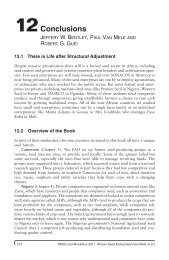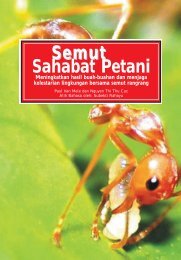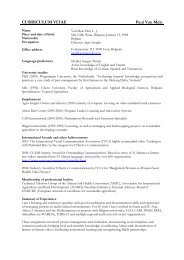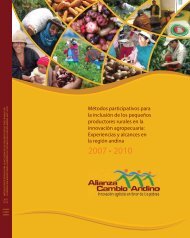Video-mediated farmer-to-farmer learning for sustainable agriculture
Video-mediated farmer-to-farmer learning for sustainable agriculture
Video-mediated farmer-to-farmer learning for sustainable agriculture
You also want an ePaper? Increase the reach of your titles
YUMPU automatically turns print PDFs into web optimized ePapers that Google loves.
multiple languages all on one disc – at which point the question was, “Do you also have this <strong>for</strong><br />
other crops?”<br />
To support the dissemination, private companies were initially reluctant <strong>to</strong> attribute resources as it<br />
was not scheduled in their annual budget plan, or because they had no idea what the DVD would<br />
look like, or because they lacked the vision that supporting the dissemination <strong>to</strong> <strong>farmer</strong>s was a<br />
route <strong>to</strong> reach out <strong>to</strong> potential cus<strong>to</strong>mers. This may change as more and more companies realize<br />
that farming can be an area of growth <strong>for</strong> their business.<br />
Most publicly funded organizations (including NGOs) and private companies offered <strong>to</strong> use their<br />
networks <strong>to</strong> distribute the DVDs as they could see the economic benefits <strong>to</strong> their partners – once<br />
they could really see what the end product was.<br />
3.4.5 Television<br />
Using either the English, French or local language versions of the rice videos, TV stations started <strong>to</strong><br />
broadcast them in The Gambia (GRTV), Uganda (UBC), Guinea (RTG), Nigeria (the federal Nigerian<br />
Television Authority as well as the state-owned Broadcasting Service of Ekiti State), Burundi<br />
(Television Nationale du Burundi), Niger (Canal3 in Malanville), DR Congo (community television of<br />
Kinzau-Mvuete) and Central African Republic (Télévision Centrafricaine).<br />
During a regional video training workshop in Bangladesh, in July 2011, one of the participants from<br />
the Ministry of Agriculture in Nepal decided <strong>to</strong> translate the rice videos made in Africa and<br />
broadcast them on the Nepal Television (NTV), using subtitles. This was done in Krisakako Sarokar<br />
(Farmer's Concern), a weekly program broadcast at 6:40 pm. The program was followed by call-ins.<br />
Later on, a Nepali voice over may be added and the videos distributed on VCD.<br />
To give an indication of the growing importance of TV in agricultural extension, from 2005 <strong>to</strong> 2011<br />
the number of TV stations in Bangladesh grew from three <strong>to</strong> 15, of which about five channels have<br />
agricultural programs.<br />
In most countries, the model has changed from one national broadcaster <strong>to</strong> a mixture of state and<br />
private funding. Also radio stations increasingly move <strong>to</strong> TV broadcasting. With an increase in TV<br />
coverage across developing countries, the demand <strong>for</strong> quality agricultural video programs and need<br />
<strong>for</strong> capacity building is on the rise.<br />
“In TV we have a weekly 30-minute programme called the Lima Time that is broadcast<br />
every Sunday on the National Broadcaster. The programme is in English. It highlights<br />
various aspects of <strong>agriculture</strong> including technical issues. The programme seems <strong>to</strong> reach<br />
mainly peri-urban <strong>farmer</strong>s. In view of this weakness, the department has procured 10<br />
audio visual mobile vans that have all studio facilities. They have been distributed in all<br />
the 9 provinces of Zambia, retaining one at HQ. The purpose of these vans is <strong>to</strong> produce<br />
<strong>farmer</strong> documentaries/ training materials and then conduct video shows. This however,<br />
has not successfully taken place because of inadequate financial resources and inability<br />
of the staff <strong>to</strong> produce these materials (need <strong>to</strong> build human capacity).”<br />
Chris<strong>to</strong>pher Mbewe, Ministry of Agriculture and Cooperatives, Zambia<br />
Community TV stations may be another option in future, although many seem <strong>to</strong> struggle with<br />
government license agreements, the same way community radio did in the past. In South Africa, <strong>for</strong><br />
<strong>Video</strong> <strong>for</strong> <strong>farmer</strong>s Agro-Insight, Oc<strong>to</strong>ber 2011 page 14







